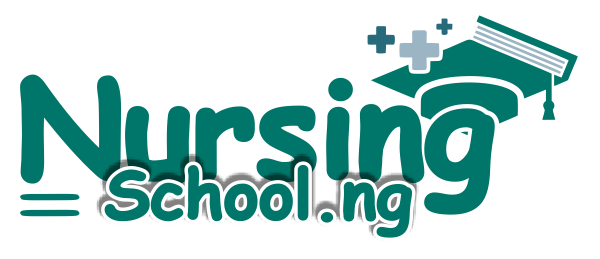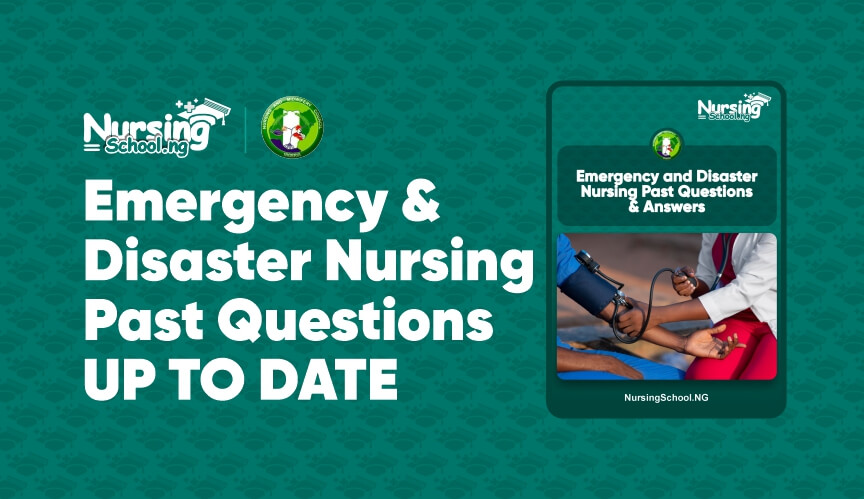- Version
- Download 1246
- File Size 4.90 MB
- File Count 1
- Create Date August 20, 2025
- Last Updated August 20, 2025
Download Emergency and Disaster Nursing Past Questions and Answers PDF. Prepare confidently for your nursing exams with this comprehensive resource tailored for nursing and medical students. Emergency and Disaster Nursing Past Questions and Answers provides an organized collection of exam-style questions with detailed solutions to help you master key concepts, enhance understanding, and succeed in your assessments.
Emergency and Disaster Nursing Exam Past Questions Key Features
This resource is designed to give you targeted, high-value content that saves time and improves exam readiness. Each feature focuses on helping you study smarter and practice more effectively:
- Comprehensive Question Coverage: Includes essential topics in emergency and disaster nursing.
- Clear, Accurate Answers: Every question comes with an explanation to support deeper learning.
- Exam-Focused Format: Mimics real exam styles, improving familiarity and reducing anxiety.
- Organized for Easy Review: Quickly find topics you need to focus on without unnecessary distractions.
Emergency and Disaster Nursing Exam Past Questions and Answers
Question 1: When caring for a patient undergoing radiation therapy, a nurse should:
A. Minimize time with patient (correct answer)
B. Be with patient all the time
C. Use hazmat
D. Wash hands
Explanation: Minimizing time limits radiation exposure.
Question 2: An emergency department charge nurse notes an increase in sick calls and bickering among the staff after a week with multiple trauma incidents. Which action should the nurse take?
A. Talk individually with staff members.
B. Remind the staff of the facility's sick-leave policy.
C. Arrange for critical incident stress debriefing. (correct answer)
D. Organize a pizza party for each shift.
Explanation: The staff may be suffering from critical incident stress and need debriefing by the critical incident stress management team to prevent long-term stress consequences.
Question 3: A 65-year-old with diaphoresis, dizziness, and left-sided chest pain arrives at triage. Priority category?
A. Urgent
B. Non-urgent
C. Emergent (correct answer)
D. High urgent
Explanation: Chest pain suggests a cardiac event
Question 4: Which client should the emergency department triage nurse classify as emergent?
A. A client with a simple laceration and soft tissue injury
B. A client with a temperature of 101
C. A client with a displaced fracture who is crying
D. A client with crushing substernal pain who is short of breath (correct answer)
Explanation: Crushing substernal pain with shortness of breath suggests myocardial infarction, which is life-threatening and requires immediate intervention.
Question 5: The 3 core functions of Public Health are the following, except:
A. Assessment
B. Assistance (correct answer)
C. Policy development
D. Assurance
Explanation: Assistance is not one of the three core functions; Assessment, Policy Development, and Assurance are.
Question 6: A patient has experienced blunt abdominal trauma from a motor vehicle accident. The nurse should explain to the patient the purpose of
A. magnetic resonance imaging (MRI)
B. ultrasonography (correct answer)
C. peritoneal lavage
D. nasogastric (NG) tube placement
Explanation: If intra-abdominal bleeding is suspected, focused abdominal ultrasonography is obtained to look for intraperitoneal bleeding. MRI would not be used. Peritoneal lavage is an alternative, but it is more invasive. An NG tube would not be helpful in diagnosis of intra-abdominal bleeding.
Question 7: An anxious 24-year-old college student complains of tingling sensations, palpitations, and chest tightness. Deep, rapid breathing and carpal spasms are noted. What priority nursing action should you take?
A. Notify the physician immediately.
B. Administer supplemental oxygen.
C. Obtain an order for an anxiolytic medication.
D. Have the student breathe into a paper bag. (correct answer)
Explanation: The patient is hyperventilating due to anxiety; breathing into a paper bag helps retain CO2 and slow breathing.
Question 8: What clinical manifestation should alert the nurse to possible fatal radiation exposure?
A. White spots all over body
B. Elevated chromosomal aberrations
C. Redness on chest
D. Decreased WBC count
Explanation: A decreased white blood cell count indicates marrow damage from radiation.
Question 9: All of the following are examples of pre-emergency social problems in predominantly social nature problems in emergencies, except:
A. Belonging to a group that is discriminated against or marginalized
B. Political oppression
C. Family separation (correct answer)
D. Extreme poverty
Explanation: Family separation is more a consequence of emergencies than a pre-existing social problem.
Question 10: Advanced airway devices include?
A. Endotracheal tube, laryngeal mask airway, combitube, esophageal tube
B. Endotracheal tube, laryngeal mask airway, combitube, oral airway, nasal airway (correct answer)
C. Endotracheal tube, laryngeal mask airway, combitube, nasal airway
D. Endotracheal tube, laryngeal mask airway, combitube, oral airway
Explanation: Includes ET tube, LMA, combitube, oral and nasal airways.
Why you Need Emergency and Disaster Nursing Exam Past Questions
Mastering emergency and disaster nursing requires understanding both theory and practical application. This resource equips you with tools to reinforce your knowledge and prepare for real test conditions:
- Strengthen your understanding of complex concepts.
- Identify weak areas and correct them with guided practice.
- Gain confidence to answer questions accurately under timed conditions.
- Prepare systematically for both school exams and professional certifications.
Benefits for Nursing and Medical Students
This study guide goes beyond rote memorization. It is structured to help you understand the rationale behind every answer, making it valuable for both classroom exams and clinical application:
- Learn how to approach and analyze exam questions logically.
- Build confidence by practicing questions aligned with your syllabus.
- Improve both theoretical knowledge and practical decision-making skills.
Stop worrying about what to study this guide gives you exactly what you need. With Emergency and Disaster Nursing Past Questions and Answers, you’ll enter your exams better prepared, more confident, and ready to achieve outstanding results.
Get your copy today and take the first step toward nursing exam success!





